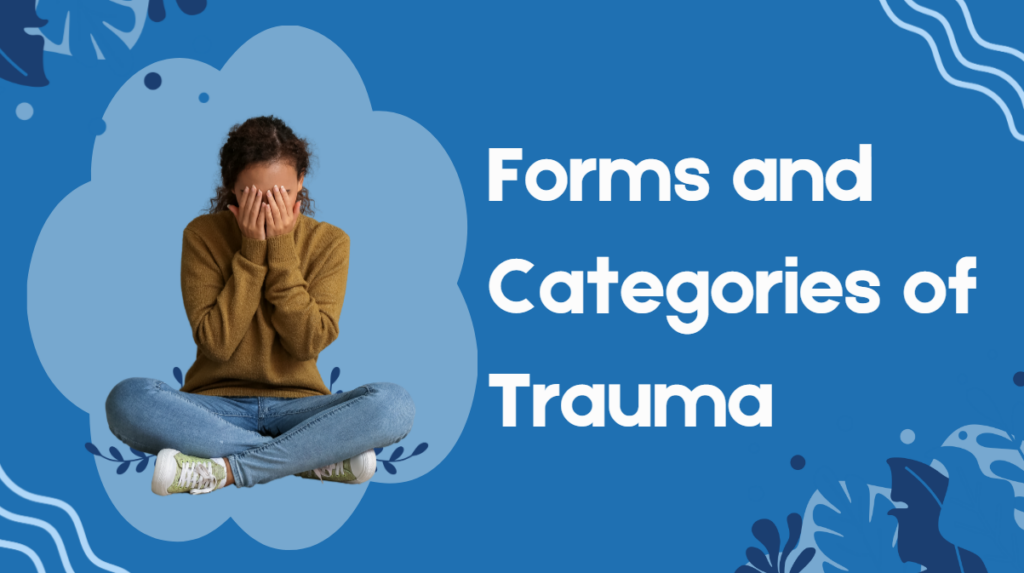
Not all wounds are visible — and not all pain begins in the present. Many people carry the weight of past experiences without realizing how deeply those memories shape their emotions, choices, and relationships today. In mental health, trauma refers to the emotional response to distressing or overwhelming experiences, whether sudden or long-term. This article explores how different types of trauma quietly influence your well-being and how healing begins when you start to face those hidden wounds.
What Is Trauma, Really?
Trauma isn’t just about what happened — it’s about what you felt and how your mind and body responded. Two people can go through the same event, but only one may experience it as trauma. Why? Because trauma occurs when an experience overwhelms your ability to cope, process, or feel safe.
In simple terms, stress becomes trauma when your nervous system can’t return to a state of balance. The event lingers in your body, creating a heightened state of alertness — even when the threat is long gone.Trauma can disrupt sleep, concentration, relationships, and even physical health.
The 3 Main Types of Trauma
Understanding the types of trauma helps clarify why some wounds run deeper than others — and why the healing process looks different for everyone. While trauma can take many forms, mental health professionals typically recognize three main categories: acute, chronic, and complex trauma.
1. Acute Trauma
Acute trauma occurs when a single, distressing experience overwhelms your sense of safety and control. This kind of trauma often comes out of nowhere — one moment you feel secure, and the next, life changes in an instant.
Common examples of acute trauma include:
- A serious car accident or near-death experience
- Experiencing or witnessing a violent assault
- A natural disaster such as an earthquake, flood, or fire
- The sudden, unexpected loss of a loved one
When acute trauma strikes, the mind and body instantly go into survival mode. Adrenaline floods your system, time feels distorted, and you may feel detached or “frozen” as your brain tries to process what just happened.
In the short term, symptoms may include:
- Shock or disbelief
- Hypervigilance or exaggerated startle response
- Intrusive memories or nightmares
- Avoidance of reminders related to the event
While many people begin to recover naturally over time, others may find the experience continues to replay mentally or emotionally. In these cases, the unprocessed trauma can develop into post-traumatic stress disorder (PTSD), leading to ongoing flashbacks, anxiety, and emotional withdrawal long after the event itself has passed.
2. Chronic Trauma
Chronic trauma develops from repeated or prolonged exposure to distressing, unsafe, or unstable environments. Unlike acute trauma, which happens suddenly, chronic trauma is slow and continuous — often leaving emotional scars that deepen over time.
Common examples of chronic trauma include:
- Ongoing physical, emotional, or sexual abuse
- Living in an environment with domestic violence
- Long-term bullying or workplace harassment
- Experiencing chronic illness or medical trauma
- Living in war zones or areas affected by ongoing conflict
Because the exposure is prolonged, the nervous system rarely returns to a calm, balanced state. The body learns to expect danger and stays on high alert, even when nothing is happening. Over time, this constant state of stress can rewire emotional and physiological responses, making it difficult to relax or trust feelings of safety.
People living with chronic trauma often struggle with:
- Low self-esteem or self-worth
- Difficulty regulating emotions
- Chronic anxiety or irritability
- Distrust or fear of intimacy
When you’ve lived in survival mode for years, calm can feel uncomfortable — even foreign. The body becomes so used to tension that peace may feel unsafe, creating cycles of anxiety or self-sabotage even in stable environments.
3. Complex Trauma
Complex trauma is the most deeply rooted type and often begins in early life. It arises from multiple or prolonged traumatic experiences, typically involving betrayal, neglect, or harm by someone the person depended on for safety — such as a parent, caregiver, or trusted authority figure.
Common examples of complex trauma include:
- Emotional neglect or manipulation by caregivers
- Physical or sexual abuse during childhood
- Repeated abandonment, rejection, or instability
- Growing up in a chaotic, unpredictable, or unsafe home environment
Unlike a single traumatic event, complex trauma shapes the foundation of how a person views themselves and the world. It doesn’t just wound — it rewires identity, attachment, and coping patterns.
Other Forms and Categories of Trauma

Beyond the three core types, several other forms of trauma shape mental and emotional health in subtle ways.
1. Developmental Trauma
This type of trauma originates in early childhood, when consistent emotional safety is missing. It doesn’t require overt abuse — even ongoing emotional neglect, invalidation, or inconsistent caregiving can disrupt a child’s sense of security.
Adults with developmental trauma often describe feeling “different” or unworthy of love. They may struggle to regulate emotions, fear abandonment, or overcompensate through perfectionism or people-pleasing.
2. Secondary or Vicarious Trauma
Secondary trauma affects those who witness or support others through trauma — such as healthcare workers, first responders, therapists, or caregivers.
Hearing stories of pain, loss, or violence repeatedly can create emotional fatigue known as compassion fatigue. Symptoms can mirror PTSD: hypervigilance, emotional detachment, and burnout. Recognizing this is vital for anyone working in helping professions.
3. Intergenerational or Historical Trauma
Sometimes, trauma doesn’t start with you. Intergenerational trauma refers to pain passed down through family systems or communities. For example, children of war survivors, refugees, or victims of systemic oppression may inherit patterns of fear, distrust, or hypervigilance — even if they didn’t directly experience the trauma.
Research in epigenetics suggests that chronic stress and trauma can even alter gene expression, affecting how future generations process emotions and stress.
4. Collective Trauma
Collective trauma affects entire communities — such as natural disasters, pandemics, mass violence, or cultural oppression. These shared experiences erode social trust and safety, influencing how groups view the world and their future.
In recent years, global events have shown how collective trauma can increase anxiety, depression, and social withdrawal, emphasizing the need for community healing, not just individual care.
How Trauma Quietly Shapes Mental Health

Trauma changes the way the brain and body function. When a person experiences overwhelming fear or helplessness, the amygdala — the brain’s fear center — becomes overactive. The hippocampus, which processes memory, may shrink, while the prefrontal cortex, responsible for reasoning and regulation, becomes less active.
This means the brain stays alert to potential threats, even when there are none. It’s why you might feel anxious for no reason, have sudden mood swings, or freeze under pressure.
Emotional and behavioral signs of unprocessed trauma can include:
- Persistent anxiety or irritability
- Emotional numbness or detachment
- Difficulty trusting or feeling safe
- Repetitive relationship patterns
- Self-sabotage or perfectionism
- Physical symptoms (fatigue, digestive issues, tension)
Trauma often hides beneath other diagnoses. People may seek help for depression, anxiety, panic attacks, or addiction, unaware that these symptoms are trauma’s quiet aftermath.
Recognizing Signs You Might Have Unresolved Trauma
Unresolved trauma often manifests as feeling “stuck.” You might notice that certain situations trigger strong emotional reactions that feel disproportionate. Or perhaps you find yourself replaying painful memories, even when you don’t want to think about them.
Common signs include:
- Feeling on edge, easily startled, or emotionally flooded
- Avoiding conflict or emotional intimacy
- Struggling to trust, relax, or connect
- Feeling detached from your emotions or body
- Constant guilt or self-blame
- Difficulty remembering parts of your past
These experiences don’t mean you’re broken — they’re your mind and body’s way of protecting you from pain that once felt unbearable. Recognizing these patterns is a brave and vital first step toward healing.
Healing from Trauma: Pathways Toward Recovery

Healing from trauma isn’t about erasing the past; it’s about helping your mind and body feel safe again. While everyone’s journey looks different, recovery often involves a combination of professional therapy, self-healing strategies, and community support.
1. The Power of Talk Therapy
Talking through painful memories in a safe, supportive space helps release what’s been held inside for too long. A trauma-informed therapist helps you explore your experiences at your own pace, understand your emotional patterns, and rebuild a sense of control and safety.
In talk therapy, you can:
- Process traumatic memories in a way that feels safe and manageable
- Rebuild self-trust and learn to respond to triggers with compassion
- Strengthen coping skills for anxiety, anger, or fear that stem from trauma
- Reclaim your sense of identity beyond what happened to you
2. Self-Healing and Daily Coping Strategies
Therapy is powerful, but daily self-care reinforces healing. Consider these gentle practices:
- Grounding exercises: Focus on your senses to return to the present (e.g., deep breathing, noticing five things you see).
- Journaling: Express emotions without judgment to understand your triggers and growth.
- Mindful movement: Yoga, walking, or stretching help release tension and reconnect you with your body.
- Rest and routine: Trauma can disrupt sleep; structure helps reestablish safety.
- Self-compassion: Replace self-criticism with curiosity. Healing requires patience, not perfection.
3. Support Systems and Community
Connection heals. Sharing your story in safe, supportive environments — whether through therapy, peer groups, or trusted relationships — can reduce isolation and shame.
Healing from trauma is non-linear; progress may come in waves. But over time, those waves grow calmer as safety and self-trust return.
When to Seek Help

You don’t have to wait until you’re in crisis to seek support. Professional help can be especially important if you experience:
- Frequent flashbacks or nightmares
- Feeling detached or emotionally numb
- Difficulty functioning at work or in relationships
- Thoughts of hopelessness, guilt, or self-harm
- A persistent sense of being unsafe
Reaching out for help is not a sign of weakness — it’s an act of courage and self-respect. Trauma may have shaped your story, but it doesn’t have to define your future.
A trauma-informed therapist can help you unpack your experiences safely, process emotions without judgment, and rebuild a sense of inner calm.
Final Thoughts: From Surviving to Thriving
Understanding types of trauma isn’t about reliving your pain — it’s about reclaiming your peace. The past may leave invisible marks, but with awareness and compassionate care, healing is always possible. You deserve a life where safety, joy, and connection are not distant hopes but everyday experiences.
If you’re ready to begin your healing journey, EmpowHer Psychiatry and Wellness is here to walk that path with you. Our trauma-informed, compassionate talk therapy helps women move from surviving to thriving with care that honors both mind and body. Contact us to schedule your appointment and take your next step toward peace and wholeness.

